|
|

|
|
Methodology
|
|
|
The research methodology consists of 3 parts:
The Story
The Case Studies
The Patterns
|
|
|
The Story
|
|
|
The story is composed with little or no reference to information technology. It is a story about building architecture derived from a review, research and analysis of selected literature. The purpose of the story is to convey ideas regarding Building Architecture in a narrative format.
|
|
|
The Case Studies
|
|
|
The case studies outline two contrasting software development projects where the author was employed as a Software Architect.
|
|
|
The Patterns
|
|
|
The patterns are derived from the story of building architecture. The case study observations are also discussed in the context of the pattern to determine which patterns are applicable using 3 indicators:
Not Applicable
Relevant
Applicable
These indicators were selected through a post review process with members of the project team.
|
|
Resarch
|
|
|
Literature Review
|
|
|
The literature review and historical analysis resulted in the compilation of the story. The sources can be found in the bibliography and include works on building architecture and architecture history.
|
|
|
Data Gathering
|
|
|
The patterns derived from the story were applied to the case study observations, workshops, interviews and discussions. Both the story and patterns were reviewed with individuals and groups from the case studies for verification, input and feedback. Each pattern was then allocated with an indicator and a context or commentary. This was important in determining whether patterns were applicable or not. In many cases, the patterns were "relevant" rather than "applicable" in that the pattern could not be observed in the context of the case study but may have some relevance. The context provided elaborates on the indicator applied.
|
|
|
Data Analysis
|
|
|
The analysis of the patterns was done iteratively in the development of the context. The context being the text provided on building architecture, architecture intensive disciplines and the two case studies respectively.
|
|
Production
|
|
|
Web Document
|
|
|
The web document uses Hypertext Markup Language (HTML), Javascript 1.2 and Dynamic HTML (DHTML) specific to Internet Explorer. It was developed using Notepad on Windows 2000 as a text editor. The formating conforms to specific authoring standards including indentation, use of all lower case and minimalism.
|
|
|
Diagrams
|
|
|
All the diagrams were developed using Microsoft Word 2000. In some instances, they were converted to Vector Markup Language (VML). The images were print screened and cropped using Paint on Windows 2000.
|
|
|
Graphics
|
|
|
All graphic images are saved as *.gif files. Icons were drawn using Paint on Windows 2000.
|
|
|